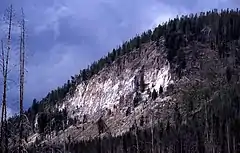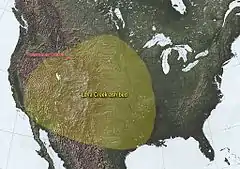Lava Creek Tuff
The Lava Creek Tuff is a tuff formation in Wyoming, Montana and Idaho, United States, created during the Lava Creek eruption around 630,000 years ago, which formed the Yellowstone Caldera.[1]
| Lava Creek eruption | |
|---|---|
 Tuff Cliff showing the Lava Creek Tuff formation | |
| Volcano | Yellowstone Caldera |
| Date | Around 630,000 years ago |
| Type | Ultra-Plinian |
| Location | Wyoming, United States 44°24′N 110°42′W |
| VEI | 8 |
 Extent of the Lava Creek ash bed | |
The Lava Creek Tuff is distributed in a radial pattern around the caldera and is formed of 1,000 km3 (240 cu mi) of ignimbrites.[2]
The tuff has been exposed by erosion at Tuff Cliff along the Gibbon River.
Lava Creek Tuff ranges in color from light gray to pale red in some locales. Rock texture of the tuff ranges from fine-grained to aphanitic and is densely welded. The maximum thickness of the tuff layer is approximately 180–200 m (590–660 ft).[3]
References
- Matthews, Naomi E.; Vázquez, Jorge A.; Calvert, Andrew T. (2015). "Age of the Lava Creek supereruption and magma chamber assembly at Yellowstone based on 40Ar/39Ar and U–Pb dating of sanidine and zircon crystals". Geochemistry, Geophysics, Geosystems. 16 (8): 2508–2528. Bibcode:2015GGG....16.2508M. doi:10.1002/2015GC005881.
- Lisa Morgan (February 10, 2004). "Yellowstone Lake Geology Talk Transcript – The floor of Yellowstone Lake is anything but quiet: Volcanic and hydrothermal processes in a large lake above a magma chamber". Yellowstone Science Talks. Archived from the original on 2004-05-01. Retrieved September 16, 2005.
- "U.S. Geological Survey Scientific Investigations Map 2816" (PDF). Retrieved May 20, 2018.
This article is issued from Wikipedia. The text is licensed under Creative Commons - Attribution - Sharealike. Additional terms may apply for the media files.
